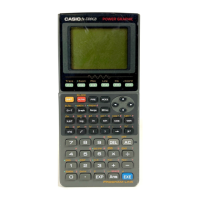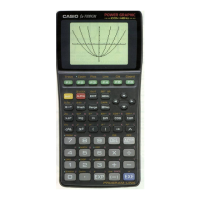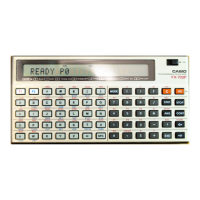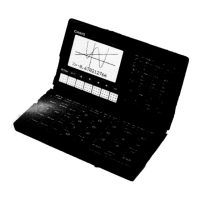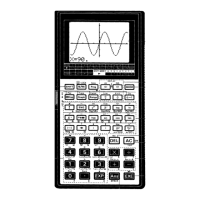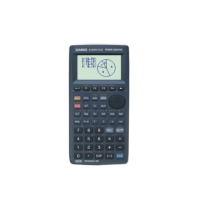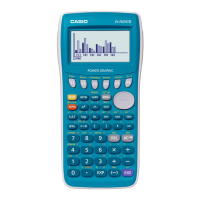
Do you have a question about the Casio fx-7700G and is the answer not in the manual?
| Brand | Casio |
|---|---|
| Model | fx-7700G |
| Category | Calculator |
| Language | English |
Details the calculator's keyboard layout, primary, shifted, and alpha functions, and key operations.
Describes various key types including cursor, mode, graph-text, range, and logarithmic/exponential keys.
Explains power/root keys, numeric keys, function memory, and coordinate transformation functions.
Covers changing calculator modes and lists available modes like RUN, COMP, STAT, REG, etc.
Details initial settings for angular measurement units, display format, decimal places, and significant digits.
Outlines fundamental operations like clearing memory, inputting, editing, and using the answer memory.
Details calculations in binary, octal, decimal, and hexadecimal number systems, including input and conversion.
Explains matrix operations including data input, size specification, arithmetic, and determinant/inverse calculations.
Describes how to store, recall, and delete functions in memory for quick access.
Explains how to switch between graphic and text displays and how to clear the text display.
Provides details on calculation priority sequence, input limitations, steps, and stack usage.
Covers basic arithmetic operations, including calculations with parentheses and order of operations.
Explains how to set and use units for angular measurements (degrees, radians) in calculations.
Details the use of sine, cosine, tangent, and their inverse functions.
Covers calculations involving logarithms (base 10, natural) and exponential functions (e^x, 10^x).
Explains the usage of hyperbolic functions like sinh, cosh, tanh, and their inverses.
Covers miscellaneous functions such as square root, powers, and other mathematical operations.
Explains how to convert between rectangular and polar coordinate systems.
Details the calculation of permutations (nPr) and combinations (nCr).
Covers calculations involving fractions, including mixed numbers and conversions to decimal.
Explains the use of engineering symbols and prefixes (like kilo, mega, milli) in calculations.
Guides on setting decimal places, significant digits, and display formats for calculation results.
Demonstrates how to use memory functions for storing and recalling values during calculations.
Covers conversions and arithmetic operations within different number systems (binary, octal, hex).
Explains the process and parameters for performing integration calculations on the unit.
Covers basic statistical analysis like mean, standard deviation, and data input/deletion.
Details regression analysis (linear, logarithmic, exponential, power) and data input for paired variables.
Provides important notes and reminders for accurate statistical calculations.
Illustrates various statistical calculations with practical examples and formulas.
Introduces the graphing capabilities and how to set the range parameters for graphs.
Explains how to graph functions in rectangular coordinates, including built-in and manually entered ones.
Details how to graph functions in polar coordinates, including manual entry.
Covers graphing parametric equations and setting range parameters for them.
Guides on graphing inequalities in the INEQ mode.
Explains how to graph integration results and use the solution range.
Describes how to graph probability distributions like P(x), Q(x), R(x) and bar graphs.
Covers drawing statistical graphs for single variables, such as bar graphs and normal distribution curves.
Details how to draw graphs for paired variables, including scatter plots and regression lines.
Explains various graph functions like trace, zoom, box, and plot selection.
Provides practical examples of graphing various functions and finding points of tangency.
Covers entering programming mode, inputting, executing, editing, and deleting programs.
Explains common error messages encountered during programming and their solutions.
Details how to check the remaining memory and count program steps.
Introduces program commands for display, input, and execution.
Explains unconditional and conditional jumps, and how to use labels in programs.
Covers the concept of subroutines and how they are used within programs.
Explains the use of array memory for simplifying programming and storing values.
Guides on displaying text messages and prompts within programs.
Details how to use the graph function within programs to display graphs.
Provides guidance on when to replace the calculator's main and backup batteries.
Lists important safety precautions related to battery handling and replacement.
Step-by-step instructions for replacing the main and backup batteries.
A critical warning about resetting the calculator and potential data loss.
Instructions on how to perform a full reset of the calculator, clearing all memory.
Summarizes manual calculation modes and their functions.
Lists the types of statistical graphs available and their modes.
Details various function types like Type A, Type B, and paired variable functions used in calculations.
Lists syntax errors, their meanings, and countermeasures.
Details memory-related errors, their causes, and how to resolve them.
Explains errors related to program jumps, their meanings, and corrective actions.
Covers nesting errors in subroutines and their resolution.
Describes errors related to stack overflow and their solutions.
Lists various mathematical functions with their valid input ranges.
Details input ranges for statistical calculations.
Lists supported graph types and functions.
Summarizes the calculator's calculation capabilities and built-in functions.
Provides general specifications including display, power, dimensions, and weight.

